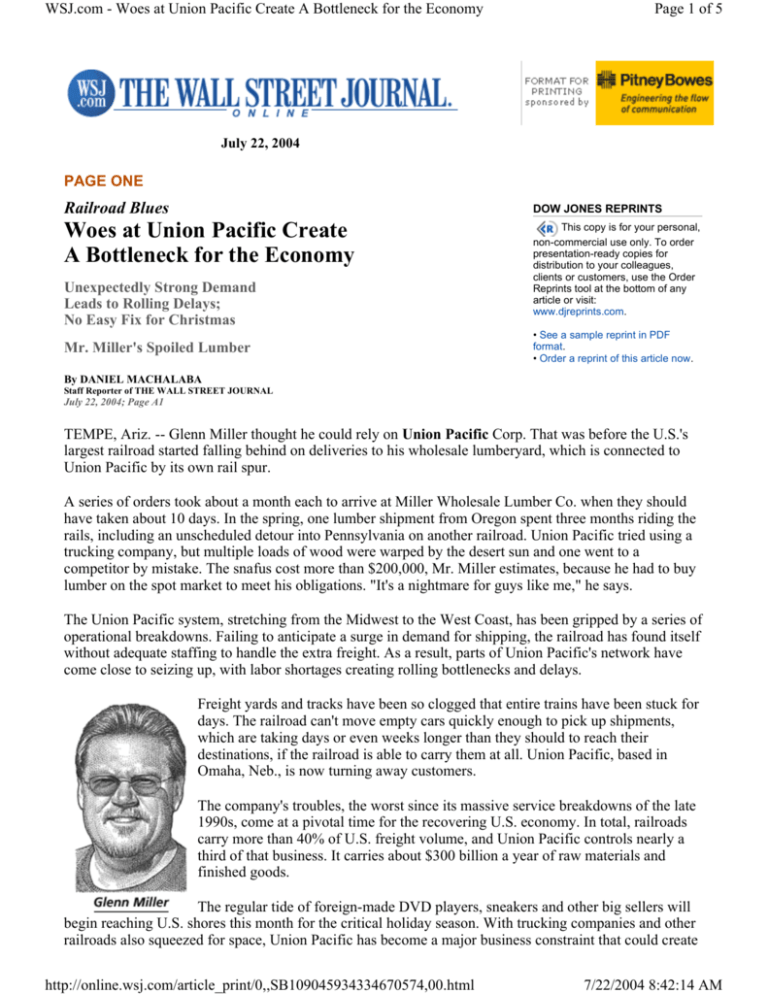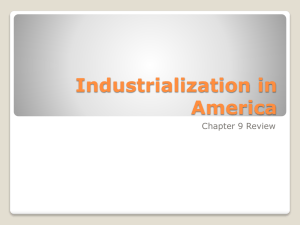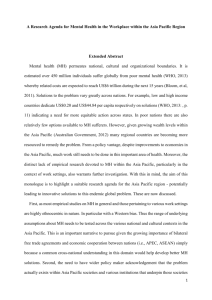
WSJ.com - Woes at Union Pacific Create A Bottleneck for the Economy
Page 1 of 5
July 22, 2004
PAGE ONE
Railroad Blues
DOW JONES REPRINTS
Woes at Union Pacific Create
A Bottleneck for the Economy
This copy is for your personal,
non-commercial use only. To order
presentation-ready copies for
distribution to your colleagues,
clients or customers, use the Order
Reprints tool at the bottom of any
article or visit:
www.djreprints.com.
Unexpectedly Strong Demand
Leads to Rolling Delays;
No Easy Fix for Christmas
Mr. Miller's Spoiled Lumber
• See a sample reprint in PDF
format.
• Order a reprint of this article now.
By DANIEL MACHALABA
Staff Reporter of THE WALL STREET JOURNAL
July 22, 2004; Page A1
TEMPE, Ariz. -- Glenn Miller thought he could rely on Union Pacific Corp. That was before the U.S.'s
largest railroad started falling behind on deliveries to his wholesale lumberyard, which is connected to
Union Pacific by its own rail spur.
A series of orders took about a month each to arrive at Miller Wholesale Lumber Co. when they should
have taken about 10 days. In the spring, one lumber shipment from Oregon spent three months riding the
rails, including an unscheduled detour into Pennsylvania on another railroad. Union Pacific tried using a
trucking company, but multiple loads of wood were warped by the desert sun and one went to a
competitor by mistake. The snafus cost more than $200,000, Mr. Miller estimates, because he had to buy
lumber on the spot market to meet his obligations. "It's a nightmare for guys like me," he says.
The Union Pacific system, stretching from the Midwest to the West Coast, has been gripped by a series of
operational breakdowns. Failing to anticipate a surge in demand for shipping, the railroad has found itself
without adequate staffing to handle the extra freight. As a result, parts of Union Pacific's network have
come close to seizing up, with labor shortages creating rolling bottlenecks and delays.
Freight yards and tracks have been so clogged that entire trains have been stuck for
days. The railroad can't move empty cars quickly enough to pick up shipments,
which are taking days or even weeks longer than they should to reach their
destinations, if the railroad is able to carry them at all. Union Pacific, based in
Omaha, Neb., is now turning away customers.
The company's troubles, the worst since its massive service breakdowns of the late
1990s, come at a pivotal time for the recovering U.S. economy. In total, railroads
carry more than 40% of U.S. freight volume, and Union Pacific controls nearly a
third of that business. It carries about $300 billion a year of raw materials and
finished goods.
The regular tide of foreign-made DVD players, sneakers and other big sellers will
begin reaching U.S. shores this month for the critical holiday season. With trucking companies and other
railroads also squeezed for space, Union Pacific has become a major business constraint that could create
http://online.wsj.com/article_print/0,,SB109045934334670574,00.html
7/22/2004 8:42:14 AM
WSJ.com - Woes at Union Pacific Create A Bottleneck for the Economy
Page 2 of 5
shortages for retailers and higher prices for customers. In addition, rail analysts are expecting a strong
grain harvest this year, which will further strain Union Pacific's system.
Robert Sappio, a senior vice president at APL Ltd., an ocean shipping line owned by Singapore's Neptune
Orient Lines Ltd., expects rail service to bog down once the peak shipping season gets under way. "I
anticipate that despite the very best efforts of our partner, the UP, there will be congestion and delays," he
says. APL serves fashion houses and other importers that need goods delivered from Asia. Its customers
are already demanding discounts because of the rail service's unreliability.
Some of Union Pacific's most valuable freight shipments are being poached by long-haul truckers and
Burlington Northern Santa Fe Corp., the railroad's chief rail competitor. But even Burlington Northern
Santa Fe, whose tracks cover much of the same territory as Union Pacific, is not taking too much
business lest its tracks also become clogged.
A Union Pacific spokesman says the railroad "clearly" has problems, which he describes as a "system
under stress, but we don't see it as a crisis." The company says it didn't foresee a surge in freight demand
because customers provided estimates that were too conservative. "We were very surprised with the
strength of the recovery," says Union Pacific Chief Executive Richard Davidson. In the first half of 2004,
Union Pacific handled more carloads than any equivalent period in its history.
The railroad is scrambling to ease its worst bottlenecks by building new tracks and bridges, particularly
along the Sunset Route that links Los Angeles and El Paso, Texas, a key route for goods imported from
Asia. Union Pacific also plans to acquire 700 extra locomotives and hire 5,000 new crew members this
year. "We're just trying to do the right things and get the resources in place," Mr. Davidson says.
Ever since it was created through an Act of Congress signed by
President Lincoln on July 1, 1862, Union Pacific has been a
crucial part of the U.S. economy. In 1869, after starting on
opposite sides of the country, the Union Pacific met the Central
Pacific in Utah where officials drove a golden spike into a
railroad tie. The first transcontinental rail network spurred
settlement of the nation's Western territories.
After the industry was deregulated in 1980, Union Pacific grew
through mergers with the Missouri Pacific, Western Pacific,
Missouri-Kansas-Texas, Chicago and North Western and
Southern Pacific railroads to become the nation's largest
railroad.
But railroads are highly inflexible and problems can quickly
multiply. Trains take a long time to start, stop and back up, and
are restricted by the track network, much of which runs on a
single track.
Union Pacific's current stumbles echo problems it faced in 1997 and 1998. Following the railroad's
merger with Southern Pacific Rail Corp., it cut costs by consolidating yards, but pared too much. The
resulting snafus marooned Midwestern crops and paralyzed ports on the West Coast.
Overseeing the company at the time was Mr. Davidson, a life-long railroad man. The 62-year-old
executive rose through the ranks to the top spot in Union Pacific in 1997 having started life as a
brakeman with the former Missouri Pacific. To better integrate his life and work, Mr. Davidson had an
old baggage car outfitted with exercise equipment so his routine wouldn't be interrupted when he traveled
on inspection trains.
http://online.wsj.com/article_print/0,,SB109045934334670574,00.html
7/22/2004 8:42:14 AM
WSJ.com - Woes at Union Pacific Create A Bottleneck for the Economy
Page 3 of 5
After the Southern Pacific debacle, he promised to transform Union Pacific by building more tracks and
transferring operational control from headquarters to the field. Union Pacific added a second track on a
key line through Kansas and a third one in south-central Nebraska, a route the company calls the busiest
in North America.
But Union Pacific's investment slowed when the economy soured. It discussed adding a track to large
sections of the Sunset Route, but completed less than initially envisioned. It also put the brakes on hiring.
Two of Union Pacific's biggest unions, the Brotherhood of Locomotive Engineers and Trainmen, and the
United Transportation Union, say the company's problems stem from not hiring enough conductors and
engineers.
In the past couple of years, there has been an exodus of senior Union Pacific employees. A retooled
retirement plan lowered the retirement age for railroad workers to 60 from 62 and many employees of the
old Southern Pacific took the opportunity to leave. Other engineers displaced by remote-control
locomotives chose to retire instead of taking long-distance assignments with irregular schedules.
As a result of the staffing shortages, Union Pacific can't easily move equipment around its network. The
average speed of its trains has fallen by three miles per hour to about 21 mph. "They played it too tight,
and it backfired," says Ed Burkhardt, president of Rail World Inc., a closely held railroad-holding
company in Chicago.
James Young, president of Union Pacific Railroad Co., the unit that operates the railroad, acknowledges
that Union Pacific has been running "too tight, particularly on crews." The Union Pacific spokesman says
the company was "quite accurate" in estimating in total how many employees would take retirement. But
forecasts in specific areas, such as individual terminals, "were wrong in a few places," he says.
As a result of its problems, Union Pacific today is expected to report second-quarter profits that are
sharply lower than the year-earlier period. The company's stock price is down 17% since the start of the
year.
Union Pacific's customers are bearing the brunt of the mess. Lyondell Chemical Co., a maker of
petrochemicals and plastics, cut some production lines this spring because raw materials were stuck on
the railroad. Moving goods by rail around Houston, where Lyondell is based, now takes seven days
instead of the usual two. These problems have cost it nearly $1 million, says a spokesman. Union Pacific
isn't always obligated to make up for customers' lost income, but in the past has paid out claims to soothe
damaged relationships.
Universal Forest Products Inc. has been forced to buy lumber on the spot market in recent months
because Union Pacific didn't deliver orders from the Pacific Northwest on time. The Grand Rapids,
Mich., company uses lumber to make crates, trusses and other building components. "It costs a lot of
money when you start adding up all the effects," says Mike Mordell, executive vice president of
purchasing, who thinks the delays have cost Universal more than $500,000.
Among the hardest hit are firms that depend on getting raw materials just before they're used in
production. As Oregon Steel Mills Inc. of Portland, Ore., waited for trainloads of natural-gas-pipeline
sections to be delivered to a customer, it had to pay $5,000 a day to the company that would eventually
unload the rail cars.
The depth of Union Pacific's problems, especially along the troubled Sunset Route, can be seen through
the May journey of Train ILBNS-18 from Los Angeles to Memphis, Tenn. The train -- 100 railcars long
and packed with imported electronics, new Toyotas and other cargo -- sat for three days past its
scheduled departure because Union Pacific had no locomotives available. The railroad divided the train
in two, to avoid blocking a grade crossing, and shunted it onto a branch line next to a high-school football
http://online.wsj.com/article_print/0,,SB109045934334670574,00.html
7/22/2004 8:42:14 AM
WSJ.com - Woes at Union Pacific Create A Bottleneck for the Economy
Page 4 of 5
field.
When Union Pacific found the locomotives, there was a two-hour delay relating to
unfinished paperwork and congestion in Union Pacific's East Los Angeles yard.
"It's a horrible system," says Michael Jarel, the train's 48-year-old engineer. "They
throw obstacles in your path." When he was ready to leave, at 6 p.m., Mr. Jarel was
blocked by locomotives moving cars around on the same track.
The Sunset Route handles up to 50 freight trains a day. Usually, trains hit the first
major bottleneck within four or five hours. This time, because of the various
delays, Mr. Jarel didn't get there until eight hours after he went on duty. There, he
halted the train at a spot where two tracks narrow to one and waited an hour for
three westbound trains to pass.
Union Pacific crews are racing to install new bridges and a new eight-mile parallel
track that will allow trains to move through the area in both directions at the same time. Mr. Jarel thinks
that will make little difference. The new track "will just move the bottleneck out further," Mr. Jarel
predicts.
Eight miles later, as the lights of Palm Springs sparkle in the distance, Mr. Jarel stopped again. This time,
he was the problem. A fresh crew was called to relieve Mr. Jarel and his conductor because they were
approaching hitting federally mandated 12-hour work limits. He was picked up by a van that drove him to
Yuma, Ariz., the official end of his route where he normally hands off to another crew.
Mr. Jarel says he often can't complete the entire 258-mile run to Yuma. Because additional crews are
drafted to deal with this kind of problem, other trains sit idle without anyone to drive them. That forces
the railroad to use employees to move waiting trains onto sidings -- and back again when they're ready to
go -- compounding the labor shortages.
The trains are sometimes parked in high-crime areas. After starting his trip, Mr. Jarel saw thieves
breaking open container doors on a nearby train. He reported the incident to a Union Pacific dispatcher
who alerted police. Union Pacific says the suspects were gone when the police arrived; it's unclear if
anything was taken.
Union Pacific is planning an infusion of locomotives and new crew members. It's hiring trainmen and
conductors, whose duties include fixing minor breakdowns. As their ranks are replenished, Union Pacific
will teach veteran conductors, who are in charge of the individual trains, how to drive them. Because that
training takes at least six months, finding enough engineers will still be a "challenge over the balance of
the year," concedes Mr. Young, the Union Pacific president. In the meantime, the company has been
turning away some of its highest-profile clients, including United Parcel Service Inc.
Union Pacific is considering reviving plans to add a second track to large portions of the Sunset Route.
Double-tracking the entire distance would cost as much as $1.5 billion, a big outlay for an industry that's
been struggling to raise rates for years. Mr. Davidson dismisses the notion that Union Pacific hasn't
invested enough in its railroad, citing the addition of a third track in Nebraska. Mr. Young says the
company is discussing raising rates with its big customers in order to accelerate modernization programs.
Few of the remedies will be completed in time for the Christmas rush. Mr. Miller says he's noticed
improvements lately in Union Pacific's service but still worries that shipments are arriving late. Standing
in his lumberyard in Tempe, he pointed to a stack of 2-by-4s that were delivered by truck instead of rail.
Because the road haulage company hired by Union Pacific didn't have enough vehicles, it stored the
lumber on the ground for three weeks, spoiling it.
http://online.wsj.com/article_print/0,,SB109045934334670574,00.html
7/22/2004 8:42:14 AM
WSJ.com - Woes at Union Pacific Create A Bottleneck for the Economy
Page 5 of 5
"I'm not selling a bright, fresh stick of wood," Mr. Miller said. "I'm selling a piece of wood that looks like
a car that hasn't been washed in a month."
Write to Daniel Machalaba at daniel.machalaba@wsj.com1
URL for this article:
http://online.wsj.com/article/0,,SB109045934334670574,00.html
Hyperlinks in this Article:
(1) mailto:daniel.machalaba@wsj.com
Copyright 2004 Dow Jones & Company, Inc. All Rights Reserved
This copy is for your personal, non-commercial use only. Distribution and use of this material are governed by our
Subscriber Agreement and by copyright law. For non-personal use or to order multiple copies, please contact Dow Jones
Reprints at 1-800-843-0008 or visit www.djreprints.com.
http://online.wsj.com/article_print/0,,SB109045934334670574,00.html
7/22/2004 8:42:14 AM










